Wadi El Rayan Egypt – Waterfalls, Lakes & Desert Adventure
Wadi El-Rayan is one of the most unique natural attractions in Egypt, featuring man-made waterfalls and scenic desert lakes created from agricultural drainage water in the Fayoum depression. It is a safeguarded region which comprises amazing sceneries, various wildlife species and amazing geographical features. Tourists can visit the two intertwined lakes found in Wadi El-Rayan, experience spectacular waterfalls and camp out in the desert. Wadi El-Rayan is perfect when going sightseeing in the desert, photoshooting as well as traveling to have some adventurous experiences, all this being possible within a range of several hours distance from Cairo.
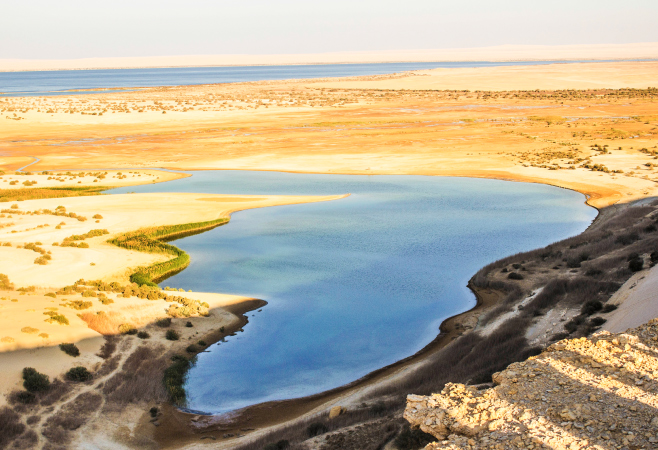
Learn more about the wonders of Wadi El-Rayan in Egypt
Overview of Wadi El-Rayan
Wadi El-Rayan, located in Egypt’s Fayoum Oasis, attracts visitors with unique waterfalls, desert lakes, and rich eco-tourism experiences.
Location
The Wadi El-Rayan is strategically positioned in the Fayoum Governorate of Egypt, going about 65 kilometers southwest of Fayoum city. This is an amazing preserved domain that lies in the Western Desert and it is approximately 150 kilometers away in Cairo via Cairo-Fayoum road. The reserve covers an area of 1,759 square kilometers comprising various territories that are made up of the desert.
Wadi El-Rayan can be reached by visitors with ease via their own means of transport or through an organized tour travelling between Cairo and Wadi El-Rayan and the drive takes about 2.5 hours. The venue has easy access to upper and lower lakes, water falls and the popular mudawwar Mountain. According to GPS coordinates, Wadi El-Rayan is located in Egypt at 29°13′N 30°23′E in one of the beautiful areas of the Western Desert.
Reason to visit
Discover the breathtaking beauty of Wadi El-Rayan, Egypt’s hidden gem! Here’s why you should visit:
- Stunning waterfalls: The only man-made waterfalls in Egypt, created by the flow of water between the upper and lower lake.
- Scenic lakes: Marvel at the serene, turquoise lakes surrounded by golden sands, perfect for photography and relaxation.
- Rich wildlife: Spot diverse species like gazelles, foxes, and migratory birds in this protected nature reserve.
- Adventure activities: Enjoy boating, kayaking, or sandboarding for an adrenaline-packed day.
- Peaceful escape: Unwind in a tranquil oasis, far from city crowds, ideal for nature lovers.
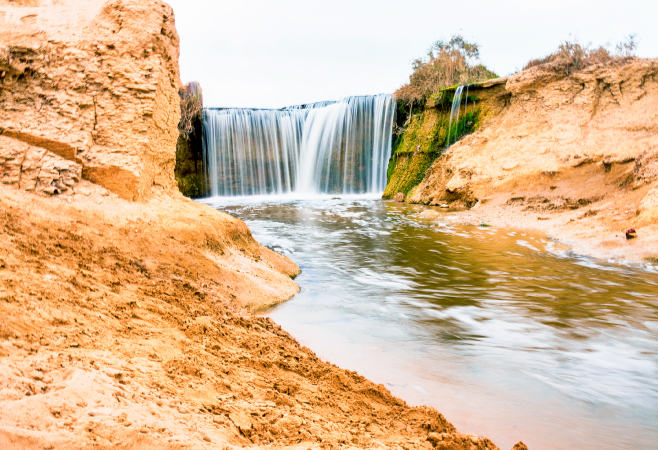
Why visit to Wadi El-Rayan
History of Wadi El-Rayan
The history of Wadi El-Rayan dates back millions of years ago and was part of an ancient sea that covered northern Egypt. A lot of archaeological facts indicate prehistoric settlements that are thousands of years old, some ancient tools and fossils have been found all over the area. The changes in the area started in 1973 when Egyptian authorities constructed artificial lakes where they used drainage agricultural water in Fayoum Governorate. This creative irrigation and water management scheme redirected surplus irrigation water to the natural depression creating the upper and lower lakes that we have today.
Wadi El Rayan became an official governmental protected area in Egypt in 1989 and was identified as the rarest ecosystems and geologic sites. The reserve has been designated as one of Egypt’s Ramsar sites since 2012, recognized for its importance to migratory birds and biodiversity conservation. The Bedouin tribes would traditionally graze sheep and seasonal camps in the valley prior to modernisation. Wadi El-Rayan is one of the cases in Egypt where the combination of human and natural factors led to the successful environmental recovery of a desert oasis and made it one of the attractions visited by thousands of people a year, protecting the natural heritage of Egypt.
Top attractions in Wadi El-Rayan
Wadi El-Rayan offers stunning waterfalls, serene desert lakes, unique wildlife, and breathtaking landscapes, making it a must-visit destination.
The Magic Lake
The Magic Lake, located near the Wadi El-Rayan reserve, is a mineral-rich lake whose color changes with sunlight and time of day. The magical appearance of the lake varies depending on the time of day; during the morning it appears blue but in the sunset the lake has an extreme turquoise color. The water is mineral built up and gives locals believe its mineral waters provide relaxation benefits. Wildlife desert species come to shoreline regularly and this offers exclusive nature viewing to the photographers and those who admire nature in Egyptian oasis.
Jabal El Modawar
The most notable geological formation in the Wadi El-Rayan is Jabal El Modawar which, literally translated as the Round Mountain. This unique mountain, which is in the shape of a circle, opens a panoramic view of the entire reserve, lakes, and western desert. Hiking people take pleasure in moderate hikes to see wonderful sunrise and sunset views. The distinctive shape of the mountain was the product of many millions of years of erosion and geologic activities. The aerial-like images of the lakes and waterfalls of Wadi El-Rayan are breathtaking as photographed by photographers. The Jabal El Modawar is an ideal place to comprehend the biographical change of the immense desert landscape in the area.
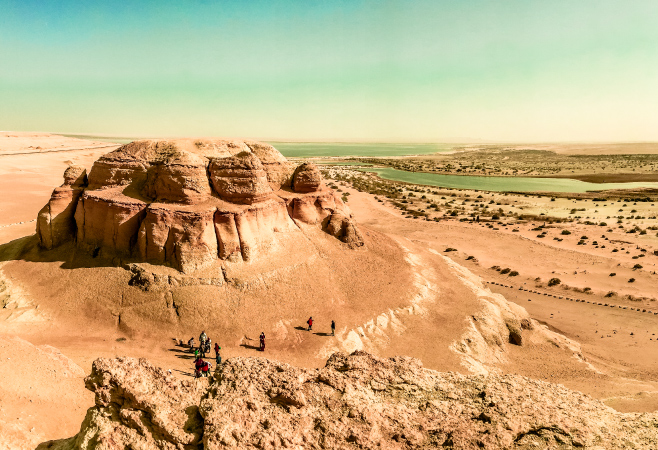
Jabal El Modawar
Wadi El Hitan
Located close to Wadi El-Rayan, is a UNESCO World Heritage Site, Wadi El Hitan, the Valley of Whales. This paleontological site is the most important repository of archaeocete whale fossils in the world, dating as far back as 40 million years ago. At the edge of a desert, visitors pay visits to open-air museums where complete skeletons of the whales are embedded in desert rock formations. The area illustrates the transition of landform to sea mammals by outstanding fossil records. Educational trails are immensely popular in guiding the tourists, as they show how the geological history of the region has given way to ancient marine life that covered the region when the Tethys Sea was present.
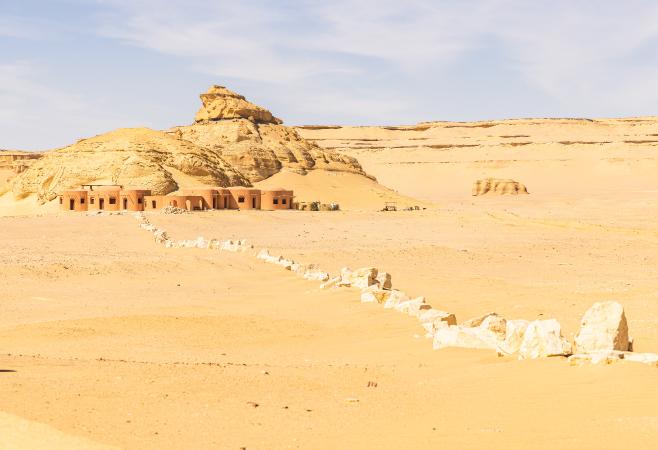
Wadi El Hitan
Medinet Madi
Near Wadi El-Rayan, you can explore fascinating archaeological sites such as Medinet Madi, an ancient Greco-Roman settlement. This is an exceptional site that is well-preserved with ruins of temples devoted to crocodile god Sobek and harvest goddess Renenutet. Constructed in the 12 th Dynasty and developed by the Ptolemies, the complex features processional routes, homes and worship facilities. Travelers find complex hieroglyphic writing, rock carvings and ruins. The location gives you a window into the life and work of the ancient Egyptian religious practices and way of life, so it is a must-visit cultural site to anyone interested in history within the Fayoum areas of Egypt.
Qasr Qarun
Located near Wadi El-Rayan, Qasr Qarun or the ancient Dionysias is a very well preserved Greco-Roman temple fortress. The limestone building was constructed in the Ptolemaic era and Biblical scholars believe it to have been a place of worship and a military fortification. The amazing architecture of the temple has survived with intact walls and chambers and decorative elements depicting the ancient method of building. The visitors examine underground galleries, ritual fields and outdoor fortifications overlooking Lake Qarun. The location has a picturesque view of the third-largest lake in Egypt and its environs. There were archaeological traces showing uninterrupted habitation since pharaonic times up to the Romans, showing the importance of the area.
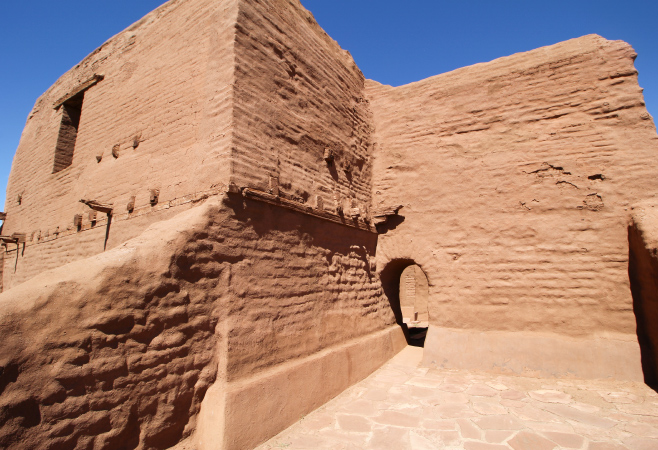
Qasr Qarun
Tunis Village
Tunis Village, a picturesque art set-up nearby Wadi El-Rayan, is a village that depicts traditional Egyptian wares and crafts. The village was established in the 1980s by the Swiss potter Evelyne Porret as a focal point of cultural activity permitting a revival of local artisanship. The tourists visit the pottery workshops, artistic galleries, and mud-built Architectural chalets overlooking lake Qarun. The village has traditional Egyptian restaurants and guesthouses with wonderful lake side settings. Cultural tours prove old types of pottery that had been transmitted to the generations. Tunis Village is a quiet oasis that is artistic and natural hence suitable for cultural tourism and exposure to the real Egypt.
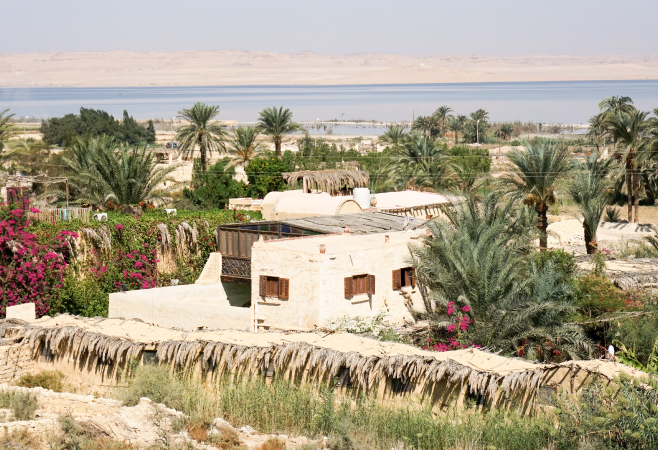
Tunis Village
If you’re interested in exploring more of Egypt’s unique landscapes beyond Wadi El Rayan, take a look at the rugged beauty of the Eastern desert in Egypt.
Best thing to do in Wadi El-Rayan
Wadi El-Rayan in the Egyptian Fayoum, is an unmissable oasis destination with amazing activities that is enjoyed by adventure seekers and nature lovers. The following are the best things to do:
- Gasp at the falls: You can see Egypt’s only man-made waterfall here, created by the flow of drainage water between the upper and lower lakes, and it is a beautiful sight.
- Boat or kayak on the lakes: Enjoy peaceful paddling across the serene turquoise waters of Wadi El-Rayan.
- Sandboard on the dunes: Feel a revelry of rolling down dunes covered with golden sand.
- Wildlife viewing: See gazelles, foxes and migratory birds in the reserve of Wadi El-Rayan.
- Hike Mudawara mountain: participate in the trek of this famous rock-range, and see breathtaking scenery of the desert.
- Photography: To capture a stunning vision of bright contrasts: turquoise lakes, gold sand and intense cliffs.
Plan your trip to Wadi El-Rayan for a perfect mix of adventure, nature, and tranquility
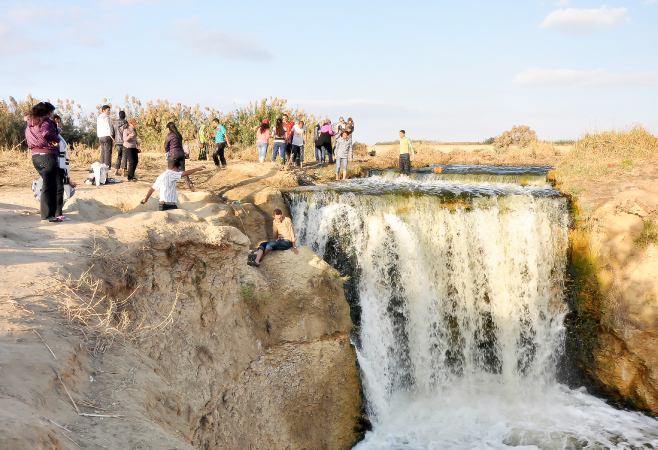
Activities in Wadi El-Rayan
After admiring the waterfalls of Wadi El Rayan, adventure lovers should head to Gabal Sha'ib El Banat — a stunning peak surrounded by dramatic desert scenery and untouched nature.
Flora and fauna of Wadi El-Rayan
Wadi El-Rayan hosts remarkable biodiversity within its desert oasis ecosystem. The protected area supports diverse wildlife species and unique plant communities adapted to arid conditions.
Wildlife species:
- Greater flamingos and little egrets migrate seasonally to the lakes.
- Desert foxes, fennec foxes, and golden jackals roam the area.
- Egyptian geese, herons, and cormorants nest along waterways.
- Gazelles and sand cats inhabit the surrounding desert regions.
- Over 169 bird species recorded including kingfishers and bee-eaters.
Plant life:
- Tamarisk trees provide shade along lake shores.
- Acacia species thrive in sandy soil conditions.
- Salt-tolerant halophytes grow near water sources.
- Desert grasses and shrubs stabilize sand dunes.
- Aquatic plants flourish in freshwater lake environments.
For a deeper look at this stunning destination and its natural wonders, you can read more about Wadi El Rayan
Tips for visiting Wadi El-Rayan
Planning your Wadi El-Rayan visit requires careful preparation for the desert environment. These essential tips ensure a safe and memorable experience exploring Egypt's stunning natural reserve.
Best time to visit:
- October to April offers ideal weather conditions.
- Avoid summer months due to extreme heat.
- Early morning and late afternoon provide perfect lighting for photography.
What to bring:
- Sunscreen, hat, protective clothing in the desert sun.
- Sufficient amount of water to keep them hydrated and snacks in between such as nuts or fresh fruits.
- Sturdy walking sandals with a good grip.
- The equipment to shoot waterfalls and landscapes.
- Cash to pay entrance fees and local purchases.
Safety guidelines:
- Travel with reliable transportation or organized tours.
- Inform someone about your travel plans.
- Stay on designated paths to protect wildlife.
- Respect swimming areas and water safety rules.
Practical advice:
- Entry fee required at park gates.
- Camping permits available for overnight stays.
- Local guides enhance cultural and natural understanding.
- Respect environmental conservation rules and regulations.
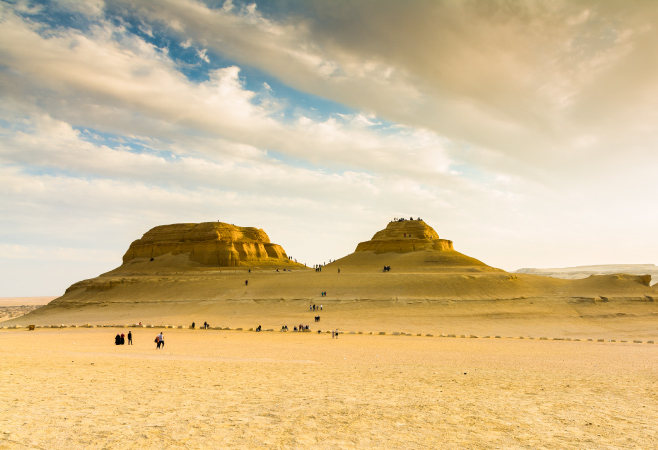
Essential advice for your Wadi El-Rayan trip
After exploring the desert landscapes and waterfalls of Wadi El Rayan, head to Serbal Mountain, one of Sinai’s most majestic peaks known for its spiritual heritage and breathtaking views.
Accommodation near Wadi El-Rayan
Finding the perfect stay near Wadi El-Rayan in Egypt’s Fayoum region is easy with these top accommodation options, offering comfort and proximity to the reserve:
- Tzila Lodge: A cozy ecolodge with lake views, offering local cuisine, free parking, and a serene atmosphere, ideal for relaxation.
- Tunis Tone Ecolodge & Campsite: Features a pool and lake views, blending rustic charm with modern comforts, perfect for nature lovers.
- Tache By The Lake: Offers pet-friendly rooms with terraces, ideal for sandboarding and boating enthusiasts.
- Zawara Ecolodge: A sustainable stay with clean, comfy rooms and desert activities like stargazing and canoeing.
- Airbnb Villas in Tunis Village: Spacious villas with pools, near Lake Qaroun, showcasing unique mud-brick architecture.
Book early to secure these authentic, nature-inspired stays for an unforgettable Wadi El-Rayan adventure!
FAQs about Wadi El-Rayan
Discover answers to the most common questions about Wadi El-Rayan, covering location, attractions, activities, travel tips, and more.
What animals might you see in Wadi El Rayan?
Wadi El-Rayan is home to rare species such as Slender-horned gazelles, fennec foxes, and sand foxes, although sightings are rare and not guaranteed. The lakes in the reserve attract migratory birds such as herons and flamingos, alongside residents like eagles, kestrels and desert larks, it declares.
Can you swim in Wadi El Rayan?
Swimming is possible in some areas near the lakes, but it is not officially supervised, the water is not clear, and currents can be strong — so it is only advised with extreme caution and at your own risk. Swimming is possible in some areas near the lakes, but it is not officially supervised, the water is not clear, and currents can be strong — so it is only advised with extreme caution and at your own risk. The water is not crystal clear, currents may vary, and there are no lifeguards, so caution and supervision are strongly advised.
How do I get to Wadi El-Rayan from Cairo?
It is located some 150 kilometers southwest of Cairo in Wadi El-Rayan. Travelling by car is the most convenient and should not take over two hours through Fayoum. Alternatively, organized day trips may be taken out of Cairo, where they typically include a car, a guide, and other local interests.
In conclusion
Wadi El-Rayan is the ideal Egyptian desert adventure that features natural cascades, exotic lakes and rich wildlife. It is a spectacular conserved area that offers unparalleled experiences of swimming with serene desert lakes to fossil exploration. EF Visa is the easiest way to apply for an Egypt e-visa online and visit the magic of Wadi El-Rayan. Wadi El-Rayan provides everything, from adventure and photography to peaceful rest as far as it offers the purest types of Egyptian wildernesses. Plan your trip to this beautiful desert oasis and visit the place which is considered the natural treasure of Egypt.
Related Articles
- Business Visa Egypt – Requirements, Fees & How to Apply
- Student Visa Egypt Guide: Requirements, Fees & Process
- 5 Year Multiple Entry Visa Egypt: Full Guide & Updates
- How much is a visa from Nigeria to Egypt? Full cost guide
- Egypt Visa Extension: How to Apply, Requirements & Guide











